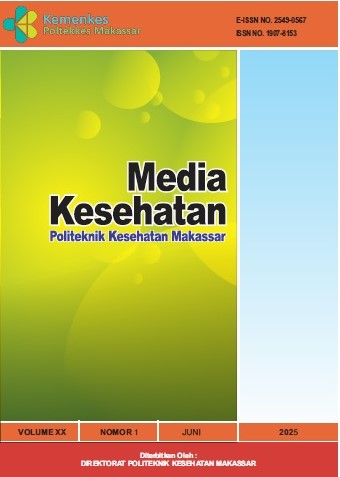Utilization of Eco-enzyme as an Innovation in Microbiological Control of Indoor Air
DOI:
https://doi.org/10.32382/medkes.v20i1.1274Keywords:
Eco Enzyme; Disinfectant; Airborne Germ Count; Indoor AirAbstract
Air in rooms contaminated by microorganisms such as bacteria can cause health problems, especially respiratory tract infections. The use of eco-enzymes as a natural disinfectant is an environmentally friendly alternative to control airborne bacteria. This study aims to determine the effectiveness of eco-enzyme at concentrations of 15%, 20%, and 25% in reducing airborne bacteria levels in indoor spaces. The research method used a Quasi-Experimental design with a Pre-Post Test Control Group. Samples were collected from three classrooms at SMA Negeri 12 Makassar using random sampling. The eco-enzyme concentrations tested were 15%, 20%, and 25%, with a contact time of 1 hour. Data were analyzed using a One-Way ANOVA test. The results showed a significant reduction in airborne bacteria levels at all concentrations: 15% reduced by 14%, 20% by 24%, and 25% by 76%. Meanwhile, the control group experienced an increase in bacterial counts by 27%. Statistical analysis showed significant differences, with the 25% concentration being the most optimal (p-value 0.0001 < 0.05). Eco-enzyme at a concentration of 25% was proven effective in reducing airborne bacteria and has potential as an environmentally friendly natural disinfectant.
This study has limitations, such as the use of a simple application method (manual sprayer) and a limited number of samples, so further research is recommended using the dry mist method and a broader sample scope.
Keywords: Eco-enzyme; Natural Disinfectant; Air Bacterial Count; Indoor Air
References
Handayani E. Analisis Risiko Mikrobiologi Udara Dalam Ruang pada Puskesmas di Kota Semarang. Karya Tulis Ilmiah. 2020. p. 1–4.
Yuliarti OA, Cahyono T, Mulyasari TM. Faktor Yang Berhubungan Dengan Angka Kuman Udara di SD Negeri Kecamatan Baturraden. Buletin Keslingmas. 2020;39(1):13–22.
Putri E, Hedy S, Purnama CI, Studi P, Interior D, Petra UK. Studi Kualitas Udara Dalam Ruang ( Indoor Air Quality ) ada Ruang Kelas Sekolah Bangunan Cagar Budaya di Surabaya. Dimensi Interior. 2016;14(2):65–71.
Ramadhoni S. Analisis Faktor Risiko Kualitas Udara Dalam Ruang Terhadap Gangguan Kesehatan di Kawasan Permukiman Kota Surabaya. Universitas Islm Negeri Sunan Ampel; 2023.
Nilandita W, Munfarida I. Analisis Hubungan Suhu Dan Kelembaban Dengan Angka Kuman Udara Di Gedung MA Sunan Ampel Surabaya. 2024;01.
Hasanah Y, Mawarni L, Hanum H. Eco Enzyme and Its Benefit For Organic Rice Production and Disinfectant. Journal of Saintech transfer. 2020;III(2):119–28.
Ekoprodjo HS, Wibowo M. Eco Enzyme As a Means of Environmental Conservation Education in Understanding Events 2:15. International Journal of Education, Information Technology and Others (IJEIT). 2024;7(April):17–23.
Nafilah DU, Rahmawati F, Tafrikan M, Khasanah N. Making A Multi Purpose Liquid (Eco-Enzyme) as An Alternative for Prosesing Household Organic Waste and Reviewing Its Benefits. Jurnal Pengabdian KOLABORATIF. 2024;2(2):17.
Harisal, Astuti NWW, Yulianthi AD, Dewi NWS, Solihin. Peningkatan Protokoler Kesehatan untuk Daerah Tujuan Wisata dengan Pelatihan Pembuatan Eco Enzyme sebagai Desinfektan di Temukus, Rendang, Karangasem. Bhakti Persada. 2022;8(2):125–33.
Zultaqawa Z, Firdaus IN, Aulia MD, Sipil JT, Indonesia UK, Raya SB, et al. Manfaat eco enzyme pada lingkungan. CRANE : Civil Engineering Research Journal. 2023;4(2):10–4.
Nurdin N, Nasihin I, Herlina N, Supartono T, Kosasih D, Nurlaila A. Pemanfaatan Sampah Organik Sebagai Biohandsanitizer Dan Biodesinfektan Berbasis Eco-Community Untuk Mencegah Penyebaran Virus Corona. Jurnal Berdaya Mandiri. 2021;3(2):578–87.
Setyoningrum Y, Yuwono AA, ... Pemanfaatan Eco Enzyme Untuk Mendukung Ekonomi Sirkular &Penciptaan Lingkungan Hidup Sehat Yang Berkelanjutan. Dikmas: Jurnal …. 2024;04(1):7–18.
Yuliana S, Handayani D. Ecoenzyme Dregs with Organic Sources of Various Types of Orange Peel. Serambi Biologi. 2022;7(1):120–6.
Marliyah L, Lutfiaazahra A, Widayati S, Harini H, Islachuddin M, Sulistyowati E, et al. Pendampingan Pembuatan Eco-Enzyme Dari Limbah Organik Menjadi Produk Yang Bermanfaat Di Kelurahan Kandri, Kecamatan Gunungpati, Kota Semarang. SANDIMAS: Seminar Nasional Pengabdian kepada Masyarakat. 2024;1(1):230–40.
Sawitri DD, Rahmawati, Erminawati. Uji Efektivitas Cairan Eco Enzyme Sebagai Desinfektan Dalam Menurunkan Angka Kuman Pada Lantai di Ruang Rawat Inap Rumah Sakit Ratu Zalecha Martapura. Seroja Husada Jurnal Kesehatan Masyarakat. 2024;1(5):372–83.
Imelda D. Pembuatan Produk Multipurpose Cleaner Dengan Pemanfaatan Eco Enzyme Dari Limbah Kulit Buah Sebagai Bahan AKtif Natural Antimikroba. Pembuatan Produk Multipurpose Cleaner Dengan Pemanfaatan Eco Enzyme Dari Limbah Kulit Buah Sebagai Bahan Aktif Natural Antimikroba. 2021.
Vidalia C, Angelina E, Hans J, Field LH, Santo NC, Rukmini E. Eco-enzyme as disinfectant: a systematic literature review. International Journal of Public Health Science. 2023;12(3):1171–80.
Vidalia C, Angelina E, Hans J, Field LH, Santo NC, Rukmini E. Eco-enzyme as disinfectant: a systematic literature review. International Journal of Public Health Science. 2023;12(3):1171–80.
Abdullah NO, Zubair A, Mangarengi NAP, Rachman RM, Tumpu M, Djamaluddin D. Identification of eco enzyme characteristics from organic waste. IOP Conference Series: Earth and Environmental Science. 2023;1268(1).
Benny N, Shams R, Dash KK, Pandey VK, Bashir O. Recent trends in utilization of citrus fruits in production of eco-enzyme. Journal of Agriculture and Food Research. 2023;13(May):100657.
Nurafina E, Hasna A, Fillah A, Pawestri SD, Ulfah M. Potensi Kewirausahaan Mahasiswa Berbasis Pemanfaatan Ecoenzyme Limbah Kulit Buah Sebagai Air Purifier. Prosiding Seminar Nasional Sains dan Entrepreneurshiiip. 2021;63–6.
Irianto IDK, Purnomo K, Amanati A, Savila D, Mardiyaningsih A. Aktivitas Antibakteri Eco-Enzyme Limbah Citrus sinensis, Musa paradisiaca L. var Bluggoe, dan Kombinasinya terhadap Staphylococcus aureus. Majalah Farmasetik. 2023;19(4):504–13.
Ginting DB, Santosa I, Trigunarso SI. Pengaruh Suhu, Kelembaban Dan Kecepatan Angin Air Conditioner (AC) Terhadap Jumlah Angka Kuman Udara Ruangan. Jurnal Analis Kesehatan. 2022;11(1):44.
Varshini B, Gayathri V. Role of Eco-Enzymes in Sustainable Development. Nature Environment and Pollution Technology. 2023;22(3):1299–310.
Vama L, Cherekar MN. Production, extraction and uses of eco-enzyme using citrus fruit waste: wealth from waste. Asian Jr of Microbiol Biotech Env Sc. 2020;22(2):346–51.
Rochyani N, Utpalasari RL, Dahliana I. ANALISIS HASIL KONVERSI ECO ENZYME MENGGUNAKAN NENAS (Ananas comosus ) DAN PEPAYA (Carica papaya L.). Jurnal Redoks. 2020;5(2):135.
Turangan LTJ, Riogilang H, Supit CJ. Pengaruh Penggunaan Eco-Enzyme Terhadap Kualitas Udara Di Tempat Pembuangan Akhir Sumompo Kota Manado. Tekno. 2024;22(88):1389–97.
Jannah M, Firdha N, Idrus HA, Farma SA. Organoleptic Test of Eco-Enzyme Products from Vegetable and Fruit Waste. Prosiding Seminar Nasional Biologi. 2021;1:198–205.
Downloads
Published
How to Cite
Issue
Section
PDF (Bahasa Indonesia) downloaded: 314















